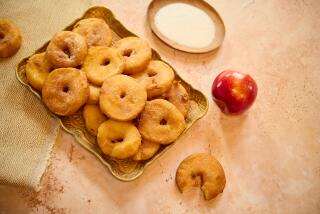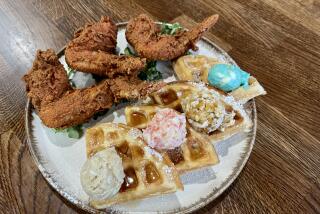Fritter and Yon
- Share via
There are things that a child simply can’t appreciate as fully as an adult. Silence, tequila and the Sunday crossword puzzle come to mind. So do corn fritters.
Perhaps my view of fritters is unduly influenced by my sadistic brother Mike. My younger brother, Brian, and I were but lads when Mike took us camping in the Sierra foothills of Northern California. Mike, now a nurse in Irvine, had a different profession then: furry hippie. He had built a wooden caravan on the back of his old truck, and he and his dog, Anima, lumbered freely along the highways and country roads of the West--I imagine to a Simon & Garfunkel soundtrack.
Brian and I were ecstatic to be under the relaxed supervision of an older brother. We read “The Hobbit” aloud, tossed a football and terrorized squirrels. Everything was great, really, until Mike served us canned corn for dinner one night.
For reasons unnecessary to explain here, I could not--and would not--eat corn in any form as a child. Brian generally ate nothing other than hot dogs, spaghetti and Cap’n Crunch, so he wasn’t thrilled about the menu either. We nibbled a path around the corn on our plates. Mike insisted that we eat it. We refused. He issued a desperate threat--and followed through with it.
The next morning we got corn fritters for breakfast.
For years, I associated the corn fritter with conflict and cruelty. I also thought it was basically a pancake with kernels of protruding corn. It took me a long time to realize that corn fritters are part of an eminent culinary tradition.
The fritter--which comes from the Latin frigere, or “to fry,” and refers to just about anything dipped in batter and fried--is nearly as old as the campfire. Back in the days of Pliny the Elder, chickpea fritters were popular at Roman dinners.
Today the varieties of fritter found around the world are “beyond count,” according to Simon and Howe’s “Dictionary of Gastronomy.” The fritter’s composition helps determine when it is eaten. Those filled with vegetables, grated or curd cheese, globe artichokes or almonds tend to be appetizers or side dishes. Fritters also can be meals in themselves, especially when they contain such ingredients as ham, prawns or anchovies. You may know them best as desserts such as the apple fritter, the French beignet (made from choux paste) or the Spanish churro.
I’ve seen corn fritter recipes that incorporate oysters, cheese, tarragon sauce or tuna. Some of the finest are spare combinations of corn kernels, batter and a little salt.
The sweet corn fritters suggested by Deborah Madison in “The Greens Cookbook” probably work best with a spicy accompaniment. If executed properly, the kernels will emerge sweet and moist, with the slightest crunch.
Just make sure you eat them immediately. Though sibling revenge is a dish best served cold, corn fritters should always be hot and fresh.
*
Sweet Corn Fritters
(Adapted from “The Greens Cookbook,” by Deborah Madison.) Yield: 48
1 cup flour
1 tablespoon salt
2 large eggs, separated
2 tablespoons olive oil
1 cup milk
2 cups sweet corn kernels (3 to 4 ears)
Light olive oil or vegetable oil for frying
Put the flour and salt in a bowl and make a well in the center. Add the egg yolks, oil and milk. Whisk everything together to make a smooth batter. Refrigerate, covered, for about 1 hour. Shave the corn kernels from the cobs and separate. After the batter has rested, gently stir in the corn. Beat the egg whites to form soft peaks and gently fold into the batter.
Pour the frying oil in a skillet up to a depth of 1/2inch. When the oil reaches 350 degrees, drop the batter by tablespoonfuls and fry, 3 minutes per side, until the fritters are a deep golden brown. Remove from the oil and drain on paper towels. Serve with chili butter, sweet pepper relish or tomato sauce, with sour cream on the side.
*
Phil Barber last wrote for the magazine about cotton suits.


